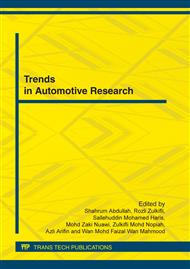p.160
p.165
p.170
p.175
p.182
p.187
p.192
p.197
p.202
Investigation of Energy Absorbed from an Instrumented Charpy Impact on Automotive Specimens
Abstract:
This paper presents the analysis of energy absorbed that produced from an instrumented charpy impact in order to evaluate the toughness of materials. Alloy rims made from aluminium 6061-T6 are easily damage, fracture and can even destroy after impact loading compared to the steel rim. For this reason, an idea was initiated to determine the strain signal pattern and strain energy for evaluting the toughness of materials. Strain gauges were experimentally connected to the data acquisition system and it was then attached to the charpy striker for the impact signal collection. Specimens of aluminium alloy of 6061-T6 and carbon steel 1050 were used and its were designed according to the ASTM E23 standard. In this work, the signal was converted from the time domain to the frequency domain using the power spectrum density (PSD) method and the area under its graph was then used to calculate strain energy. The comparison between absorbed energy and strain energy was performed based on different materials and thicknesses. It was found the effect of the strain signal pattern with different materials and thicknesses to be influnced the strain energy.
Info:
Periodical:
Pages:
182-186
Citation:
Online since:
April 2012
Authors:
Keywords:
Price:
Сopyright:
© 2012 Trans Tech Publications Ltd. All Rights Reserved
Share:
Citation:


